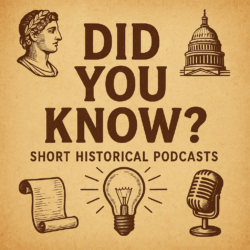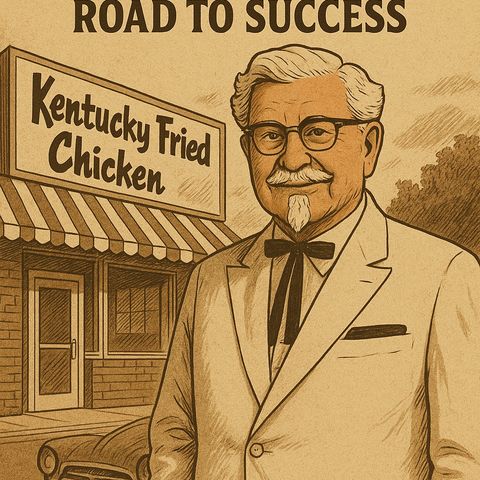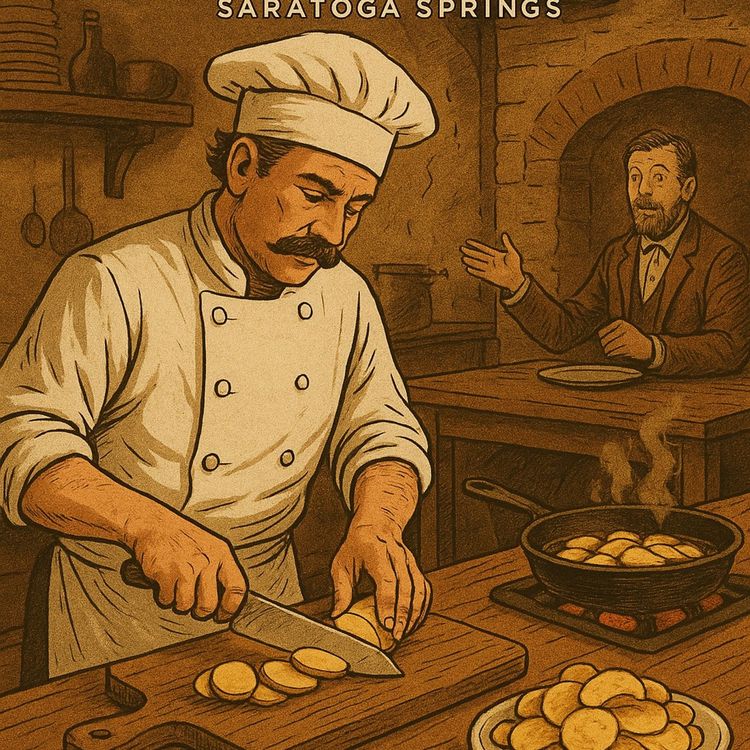This is an automatically generated transcript. Please note that complete accuracy is not guaranteed.
Did You Know? – About The Real Colonel Sanders’ Road to Success?
Welcome to our podcast where surprising truths from history are served up fresh in every episode.
Today, we unwrap the real story behind one of the most iconic faces in fast food: Colonel Harland Sanders. You know the white suit, the string tie, the goatee. But did you know the Colonel didn’t find success until his 60s? His journey is one of grit, failure, reinvention — and ultimately, a bucket of success.
Born in 1890 in Henryville, Indiana, Harland Sanders grew up fast. His father died when he was just five years old, leaving young Harland to care for his siblings while his mother worked. By the age of seven, he had learned to cook — not by choice, but by necessity. And this early start in the kitchen would stay with him for life.
Sanders dropped out of school in the sixth grade. He worked an astonishing range of jobs over the years: farmhand, streetcar conductor, railroad fireman, insurance salesman, and even a steamboat pilot. He also studied law for a brief period and practiced it — until he got into a courtroom brawl with his own client. Needless to say, the legal profession didn’t last long.
By the 1930s, Sanders had settled in Corbin, Kentucky. He was running a service station and began cooking meals for travelers out of the back room. He served hungry drivers fried chicken, ham, biscuits, and string beans. His cooking was so good that he eventually opened a full restaurant across the street — the now-famous Sanders Court & Café.
In 1935, Kentucky Governor Ruby Laffoon gave Harland Sanders the honorary title of “Colonel” in recognition of his contributions to Kentucky cuisine. From that point forward, Harland embraced the role with showmanship — white suit, black string tie, goatee — creating the image that would eventually become globally recognized.
But his big break still hadn’t come. Sanders spent the 1940s perfecting his fried chicken recipe. He used a pressure cooker to cut down the frying time while retaining flavor and moisture. His blend of 11 herbs and spices — a closely guarded secret to this day — became the centerpiece of his menu.
However, tragedy struck in the 1950s. The construction of a new interstate highway diverted traffic away from his restaurant, which eventually forced him to sell it at a loss. Sanders, now in his 60s, had just his pressure cooker, a few spices, and a dream.
That’s when he hit the road.
With nothing but determination and a battered old car, Sanders began traveling the country, cooking his chicken in small restaurants and diners, offering them a deal: make his recipe, and he’d take a cut of the profits. Rejection followed him everywhere. Some estimate he heard the word “no” over a thousand times before someone said yes.
But he kept at it. And finally, one restaurant owner agreed. Then another. Word spread. By 1964, Sanders had franchised over 600 locations. That same year, he sold the Kentucky Fried Chicken corporation for $2 million — a massive sum at the time — but he stayed on as the brand’s ambassador, appearing in ads and public appearances, always in character.
It’s easy to forget that Sanders didn’t find real success until the latter part of his life. At an age when most people retire, he was just getting started. And while the corporate version of KFC grew into a global fast-food empire, Sanders never stopped caring about the quality of the food that bore his name.
He remained a vocal critic of KFC’s corporate shortcuts and changes to his original recipe. In one now-infamous interview, he even called the gravy “wallpaper paste.” Despite his commercial image, Sanders was a real person — fiercely proud, stubborn, and passionate about good food.
There’s a lot to take away from Colonel Sanders’ story. For one, age doesn’t have to define your peak. He reinvented himself not once, not twice, but many times over. His life was marked by hardship and hustle, with plenty of setbacks in between.
And perhaps most importantly, Sanders turned personal failure into brand legacy. His image, his recipe, and his entrepreneurial persistence became something more than the sum of its parts. In a culture obsessed with overnight success, Sanders’ story reminds us that sometimes, the best things take time — and a lot of fried determination.
So next time you see that smiling face on a red-and-white bucket, remember: it wasn’t just marketing. It was the story of a man who failed his way to global fame, and fried up the American Dream in the process.
Thanks for listening to Did You Know? If you enjoyed today’s episode, subscribe and share with a friend who appreciates stories with unexpected twists. Until next time, stay curious — because every icon has a backstory.
For more information on our podcast, visit our website: DidYouKnow.Life.
Until next time, stay curious.
Title Did you know about the real Colonel Sanders’s road to success? Welcome to our podcast, where surprising truths from history are served up fresh in every episode. Today we unwrapped the real story behind one of the most iconic faces in fast food, Colonel Harland Sanders. You know the white suit, the string tie, the goateee. But did you know the colonel didn’t find success until his sixties.
His journey as one of grit, failure, reinvention, and ultimately a bucket of success. Born in eighteen ninety in Henryville, Indiana, Harlan Sanders grew up fast. His father died when he was just five years old, leaving young Harlan to care for his siblings while his mother worked. By the age of seven, he had learned to cook, not by choice, but by necessity, and this early start in the kitchen would stay with him for life.
Sanders dropped out of school in the sixth grade. He worked an astonishing range of jobs over the years, farm hand, streetcar conductor, railroad fireman, insurance salesman, and even a steamboat pilot. He also studied law for a brief period and practiced it until he got into a courtroom. Brawl with his own client.
Needless to say, the legal profession didn’t last long. By the nineteen thirties, Sanders had settled in Corbin, Kentucky. He was running a service station and began cooking meals for travelers out of the back room. He served hungry drivers fried chicken, ham biscuits, and string beans.
His cooking was so good that he eventually opened a full restaurant across the street, the now famous Sanders Court and Cafe. In nineteen thirty five, Kentucky Governor Ruby Laffoon gave Harlan Sanders the honorary title of Colonel in recognition of his contributions to Kentucky cuisine. From that point forward, Harland embraced the role with showmanship, white suit, black string tie, go tee, creating the image that would eventually become globally recognized. But his big break still hadn’t come.
Sanders spent the nineteen forties perfecting his fried chicken recipe. He used a pressure cooker to cut down the frying time while retaining flavor and moisture. His blend of eleven herbs and spices, a closely guarded secret to this day, became the centerpiece of his menu. However, tragedy struck in the nineteen fifties.
The construction of a new interstate highway diverted traffic away from his restaurant, which eventually forced him to sell it at a loss. Sanders, now in his sixties, had just his pressure cooker, a few spices, and a dream. That’s when he hit the road with nothing but determination. In a battered old car.
Sanders began traveling the country, cooking his chicken in small restaurants and diners, offering them a deal. Make his recipe and he’d take a cut of the profits. Rejection followed him everywhere. Some estimate he heard the word no over a thousand times before someone said yes.
But he kept at it, and finally one restaurant owner agreed. Then another word spread. By nineteen sixty four, Sanders had franchised over six hundred locations. That same year, he sold the Kentucky Fried Chicken Corporation for two million dollars, a massive sum at the time, but he stayed on as the brand’s ambassador, appearing in ads and public appearances, always in character.
It’s easy to forget that Sanders didn’t find real success until the latter part of his life. At an age when most people retire, he was just getting started. And while the corporate version of KFC grew into a global fast food empire, Sanders never stopped caring about the quality of the food that bore his name. He remained a vocal critic of KFC’s corporate shortcuts and changes to his original recipe.
In one now infamous interview, he even called the gravy wallpaper paste. Despite his commercial image, Sanders was a real person, fiercely proud, stubborn, and passionate about good food. There’s a lot to take away from Colonel Sanders’ story. For one, age doesn’t have to define your peak.
He reinvented himself, not once, not twice, but many times over. His life was marked by hardship and hustle, with plenty of setbacks in between, and perhaps most importantly, Sanders turned personal failure into brand legacy. His image, his recipe, and his entrepreneurial persistence became something more than the sum of its parts. In a culture obsessed with overnight success, Sanders’ story reminds us that sometimes the best things take time and a lot of fried determination.
So next time you see that smiling face on a red and white bucket. Remember it wasn’t just marketing. It was the story of a man who failed his way to global fame and fried up the American dream in the process. Thanks for listening to digit Know.
If you enjoyed today’s episode, subscribe and share with a friend who appreciates stories with unexpected twists. Until next time, stay curious because every icon has a backstory. For more information on our podcasts, visit our website Did you Know Life Dot?
Until next time, stay curious.


